| home page |
latest news |
news
archive 2015 |
news
archive 2014 |
news
archive 2003-2010 |
|
Click
on a thumbnail to
enlarge.
|
 |
 |
 |
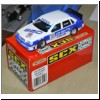 |
Other competition entries in October included a selection made by Spot-on and International Model Aircraft under licence from Transogram; a pair of ‘The Winner’ racing cars by Toy Products Ltd of Walsall; a collection of four-wheel drive slot cars by MRRC; a selection of French models by Minialuxe, Danone and Clé; and a Marx model of a Ferguson racing car.
 |
 |
 |
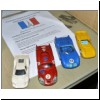 |
 |
Click
on a thumbnail to
enlarge.
SEPTEMBER 2016
Unfortunately the speaker
for our September clubnight was unable to attend, so we ended up with a
‘social’ evening which was still enjoyable. The competition on
the theme of ‘Aston Martin and Spy-related Cars’ produced a very
interesting range on display, with some thought having gone into many
of the entries.
First prize went to David Arnold for a second-hand car sales lot of ex-007 cars with some witty descriptions. Second was the biggest model on the table, Gary Maslin’s kit-built Aston Martin DB5. In third place was a display of Corgi 007 models, inspired by the 60th anniversary of Corgi Toys and comprising a model for each of the six decades since the first James Bond car. This was entered by Adrian Levano. In fourth place was John Garside’s selection of Maxwell Lotus Esprits made in India, complete with boxes and still in the original plastic bags. The selection of colours contrasts with the single colour of the Corgi Juniors model from which the Maxwells were copied.
First prize went to David Arnold for a second-hand car sales lot of ex-007 cars with some witty descriptions. Second was the biggest model on the table, Gary Maslin’s kit-built Aston Martin DB5. In third place was a display of Corgi 007 models, inspired by the 60th anniversary of Corgi Toys and comprising a model for each of the six decades since the first James Bond car. This was entered by Adrian Levano. In fourth place was John Garside’s selection of Maxwell Lotus Esprits made in India, complete with boxes and still in the original plastic bags. The selection of colours contrasts with the single colour of the Corgi Juniors model from which the Maxwells were copied.
 |
 |
 |
 |
Among the other entries
were Robert Newson’s models of the Aston Martin Series III of 1934-6 by
MAFWO (Mears & Freeman Woodware), an Aston Martin sculpted in soap,
and a selection of Jaguar XKR Cabriolets as featured in Die Another Day in a range of
scales.
 |
 |
 |
Click
on a thumbnail to
enlarge.
AUGUST 2016
August clubnight was our
Fish and Chip Supper, so without a speaker or presentation it was a
very social evening with discussions about various items members had
brought with them. A few ‘deals’ also seem to have taken place.
The competition ‘Food on Wheels’ gave a wide scope, with entries ranging from some quite rare models to amusing items like an egg cup in the form of a cart being pushed by a chicken. First prize went to Brian Gatward’s Chad Valley tinplate snack bar ‘Mac’s Snacks’. This model was originally described by the manufacturers as a ‘Buffet Car’. In second place was Mike Forbes’ Tekno Ford D Series articulated truck in the livery of ‘Frisko is’. This has well-detailed refrigeration equipment rather than the more common plain box attached to a standard box body. Having said that, this looks a bit vulnerable to damage both in real and model form!
Third was Roger Coles’ Dinky Albion Milk Marketing Board tanker, one of the Dinkies Dinky never made, and fourth place went to Geoff Holden for a clever kitchen improvisation – the Chevy Courgette, complete with Chevrolet badge. We hope this was recycled as part of dinner the following evening as two courgettes went into the manufacture of this model!
The competition ‘Food on Wheels’ gave a wide scope, with entries ranging from some quite rare models to amusing items like an egg cup in the form of a cart being pushed by a chicken. First prize went to Brian Gatward’s Chad Valley tinplate snack bar ‘Mac’s Snacks’. This model was originally described by the manufacturers as a ‘Buffet Car’. In second place was Mike Forbes’ Tekno Ford D Series articulated truck in the livery of ‘Frisko is’. This has well-detailed refrigeration equipment rather than the more common plain box attached to a standard box body. Having said that, this looks a bit vulnerable to damage both in real and model form!
Third was Roger Coles’ Dinky Albion Milk Marketing Board tanker, one of the Dinkies Dinky never made, and fourth place went to Geoff Holden for a clever kitchen improvisation – the Chevy Courgette, complete with Chevrolet badge. We hope this was recycled as part of dinner the following evening as two courgettes went into the manufacture of this model!
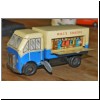 |
 |
 |
 |
Click
on a thumbnail to
enlarge.
JULY 2016
 July
saw the return of Deborah from Milestones Museum in Basingstoke with
‘More Amusing Tales from the Museum’. Milestones, which is
situated close to the old Thornycroft factory, is focused around two
‘streets’, one on a Victorian theme, the other post-Second World
War. As well as hearing about the reactions of visitors,
especially the children, we heard about some of the out-reach
activities of the museum including craft classes and visits to clubs
and societies. There were also stories about mysterious goings-on
at Milestones, some possibly due to hauntings.
July
saw the return of Deborah from Milestones Museum in Basingstoke with
‘More Amusing Tales from the Museum’. Milestones, which is
situated close to the old Thornycroft factory, is focused around two
‘streets’, one on a Victorian theme, the other post-Second World
War. As well as hearing about the reactions of visitors,
especially the children, we heard about some of the out-reach
activities of the museum including craft classes and visits to clubs
and societies. There were also stories about mysterious goings-on
at Milestones, some possibly due to hauntings.The competition was ‘Models made in or relating to Hampshire’, and was judged by Deborah and Sarah, our visitors from Milestones. The first prize went to Robert Newson for a very unusual saloon car by Phillip Segal Toys. A reproduction of their catalogue described them as makers of ‘Hollow Cast Metal Toys’ - most of which were figures and animals. The catalogue showed two motor vehicles, the saloon car (no.41) as well as a racing car (no.42), and gave the company address as Christchurch, Hants.
Second prize went to a Dinky Mighty Antar tank transporter set belonging to Roger Coles. In third place was a smaller version of the tank transporter from the Sentry Box range entered by Hilary Gatward. Fourth place went to Adrian Levano for a Corgi Classics set featuring Hampshire Police vehicles – a Bedford S Control Unit van and a Morris 1000 van.
 |
 |
 |
 |
Click
on a thumbnail to
enlarge.
JUNE 2016
 In June Kevin Bailey gave a very well illustrated and
informative presentation on the history of Rolls-Royce, from the
earliest activities of the founders (and their very different
backgrounds) through the various models produced over the decades; that
included the wartime applications, especially the armoured cars
including those used by T.E. Lawrence (Lawrence of Arabia). Kevin
suggested that these military vehicles could easily provide sufficient
interest for a future talk, so we look forward to hearing that at some
time in the future. Among items on display was
the radiator grille from Kevin’s ‘spare’ Silver Shadow. One of the
photos in his presentation was of a whole scrapyard of similar vehicles.
In June Kevin Bailey gave a very well illustrated and
informative presentation on the history of Rolls-Royce, from the
earliest activities of the founders (and their very different
backgrounds) through the various models produced over the decades; that
included the wartime applications, especially the armoured cars
including those used by T.E. Lawrence (Lawrence of Arabia). Kevin
suggested that these military vehicles could easily provide sufficient
interest for a future talk, so we look forward to hearing that at some
time in the future. Among items on display was
the radiator grille from Kevin’s ‘spare’ Silver Shadow. One of the
photos in his presentation was of a whole scrapyard of similar vehicles.We were also pleased to welcome Ann Evans and photographer Rob Tysall who are planning an article about the club for Diecast Collector and/or Collectors Gazette. Our guests kindly agreed to judge the competition which was on the theme ‘Silver Coloured Toys’, with first prize going to Gary Maslin for his ‘Streamline Car’. This is by Mettoy in the ‘Castoys’ series. Normal versions are cream, red or green with a red interior, however other colour versions do exist – the chrome plated model being one of the rare variations. The catalogue number is 810 and it was in production only for a short period (1948-50). All cars carry the number plate MTY 810.
Second prize went to Adrian Levano for a display of Märklin models, all reissues of earlier items but produced for three different markets. Third was won by a pair of autographed Stirling Moss Mercedes-Benz racing cars belonging to David Arnold. Fourth was Phil Dyer’s silver White 4-210 tractor in 1:32 scale made by Ertl for the 2013 National Farm Toy Show.
 |
 |
 |
 |
Click
on a thumbnail to
enlarge.
MAY 2016
 At
the May clubnight, Jim Lindsay gave a very interesting talk on the
differences in production processes of toys on the other side of the
Atlantic Ocean compared with those in Europe.
During the 1920s and '30s,
many American cast iron toys were produced by general foundries, with
some of the ‘top end’ items being quite large and incorporating moving
parts. During the depression smaller cast iron items were popular
as they were more affordable. Some production of older
style cast iron toys continues as nostalgia items for collectors.
At
the May clubnight, Jim Lindsay gave a very interesting talk on the
differences in production processes of toys on the other side of the
Atlantic Ocean compared with those in Europe.
During the 1920s and '30s,
many American cast iron toys were produced by general foundries, with
some of the ‘top end’ items being quite large and incorporating moving
parts. During the depression smaller cast iron items were popular
as they were more affordable. Some production of older
style cast iron toys continues as nostalgia items for collectors.Slush casting was another process most commonly used in the USA, but with the lack of makers’ marks in most cases, identification can be tricky. Rubber toys also enjoyed a fairly brief popularity, being sold as ‘furniture friendly’ but although there was some production after the Second Word War, this was soon replaced as a material by soft plastics.

Another material more common in US production is pressed steel, with the bigger toys (referred to as ‘yard toys’) sometimes having a thickness of metal equivalent to that of real cars. Jim had a wide selection of items from his own collection on show, some of which are shown in these photos.
The competition was on the theme ‘50s/60s American Cars’ with first prize going to John Garside for a selection of Israeli-made Sabra/Cragstan/GamdaKoor models. Second was Robert Newson’s display of Lone Star Roadmasters with publicity material describing them as ‘The Big Strong Cars... for Collectors’. All the models pictured were American vehicles with the exception of the Rolls-Royce and a Citroen DS. This range was marketed by Tootsietoy in the USA, so both first and second prize winners were models made for export to the American market. Third was a scrapyard of Tootsietoys (and others) from Roger Coles, with fourth place going to a Prince tribute from Adrian Levano featuring the single sleeve and ‘Little Red Corvettes’ from the Matchbox-Dinky range and Schuco Piccolo.
 |
 |
 |
 |
Click
on a thumbnail to
enlarge.
APRIL 2016
In April Geoff Holden
followed up his previous talk on speed record models with a
presentation about the real things. We learned that France was
the location for the first speed record attempts with the earliest
being set by electric cars. The 75 mph barrier was then first broken by
a steam car which apparently still runs! In 1904 the first car to
achieve 100 mph was powered by petrol, and Geoff continued to chart the
progress of higher and higher speeds being attained and the
famous cars that were involved. The current record of 763 mph is
held by Andy Green driving the Thrust SSC in 1997, although there are
various projects which aim to exceed this speed. The problems of
exceeding the speed of sound were also explained. Despite some heckling from
the ‘noisy’ exhibits on the competition table, Geoff then told us about
water speed records including the high fatality rate of those
attempting ever higher speeds.
The competition was ‘Noisy Toys’ and was not limited to wheeled vehicles, as the opera-singing duck demonstrated. The winners of the competition were as follows: first was Hilary Gatward for the tin drummer boy and second Brian Gatward for his pile of drums (is there a family trend emerging here?). Third was Clive Gehle for his Playmate ‘Sturdytoy’ Puffing Billy, and fourth George Bennett for the Dodge Charger ‘General Lee’ from the TV series Dukes of Hazzard.
The competition was ‘Noisy Toys’ and was not limited to wheeled vehicles, as the opera-singing duck demonstrated. The winners of the competition were as follows: first was Hilary Gatward for the tin drummer boy and second Brian Gatward for his pile of drums (is there a family trend emerging here?). Third was Clive Gehle for his Playmate ‘Sturdytoy’ Puffing Billy, and fourth George Bennett for the Dodge Charger ‘General Lee’ from the TV series Dukes of Hazzard.
 |
 |
 |
 |
Click
on a thumbnail to
enlarge.
MARCH 2016
March was the club's Annual
General Meeting, and the chop, kit and restoration competition was held
on the same evening. The winning kit was an
Airfix plastic internal combustion engine, and the restoration prize
went to a Northern Tynesider/Wearsider Routemaster Bus. Both were entered by John
Bennett. The chop competition was
won by Paul Rowley with a crane representing a vehicle operated by the
Uplifting Crane Co. Powered by a Scammell
Crusader, with four-axle steering and lift rated at 60 tons, this would
have been quite a serious piece of equipment.
The annual trophies were awarded as follows:
- The Harry Gunner Trophy, awarded to the winner of the chop competition, went to Paul Rowley.
- The John Parker Trophy, awarded for the most points collected in clubnight competitions, was won by Geoff Holden.
- The Dave Robinson Trophy (formerly the participation cup) went to Roger Coles for taking part in the most competitions over the year but unfortunately not being within the prizewinners.
- The Tony Gleave Trophy, awarded for exceptional club effort over the past year went to Adrian Levano, for editing the club magazine Wheel Bearings.
The annual trophies were awarded as follows:
- The Harry Gunner Trophy, awarded to the winner of the chop competition, went to Paul Rowley.
- The John Parker Trophy, awarded for the most points collected in clubnight competitions, was won by Geoff Holden.
- The Dave Robinson Trophy (formerly the participation cup) went to Roger Coles for taking part in the most competitions over the year but unfortunately not being within the prizewinners.
- The Tony Gleave Trophy, awarded for exceptional club effort over the past year went to Adrian Levano, for editing the club magazine Wheel Bearings.
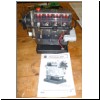 |
 |
 |
Click
on a thumbnail to
enlarge.
FEBRUARY 2016
In
February we welcomed back Tim Morris of Brooklands, who gave us another
interesting and well-illustrated talk, entitled ‘Fast Women, Fast
Track’. This was about the pioneering women of motoring and motor
sport and their connections to the Brooklands circuit. After an
opening display of (hopefully tongue-in-cheek) cartoons about female
stereotypes associated with motoring, we heard about Bertha Benz who
seems to have been the marketing brains behind her husband Carl, making
an enterprising drive with one of the earliest cars in the world.
We then learned about some early female drivers and their exploits,
both on and off the track, often against the odds of bans on their
participation. Prominent among those was Ethel Locke King, wife
of Hugh, the force behind the world’s first motor racing circuit.
What seemed clear was that the spirit which drove them often led
to success in other fields – and in many cases very long lives
(accidents excepted). There was also the incident of the ‘Society
Ladies' Race’ at Brooklands which appears to have been a publicity
stunt arranged by Barbara Cartland; with some of the ‘ladies’ not being
quite as pure as they would have liked to have been thought...
The competition ‘Tins with a Transport Theme’ produced an interesting display of many different sized items. The winner was a display of biscuit and toffee tins (and a spark plug tin) featuring Sir Henry Seagrave’s Golden Arrow, entered by Geoff Holden. Second was Gary Maslin’s van for M Méert Confectioners and Chocolatiers of Lille. This is not as old as the style and typography would suggest, the giveaway being the phone number with an international dialing code printed on the rear! In third place was Hilary Gatward’s McVitie’s Jaffa Cakes Express, with the (very large) Cookie Train belonging to Philip Turland fourth.
The competition ‘Tins with a Transport Theme’ produced an interesting display of many different sized items. The winner was a display of biscuit and toffee tins (and a spark plug tin) featuring Sir Henry Seagrave’s Golden Arrow, entered by Geoff Holden. Second was Gary Maslin’s van for M Méert Confectioners and Chocolatiers of Lille. This is not as old as the style and typography would suggest, the giveaway being the phone number with an international dialing code printed on the rear! In third place was Hilary Gatward’s McVitie’s Jaffa Cakes Express, with the (very large) Cookie Train belonging to Philip Turland fourth.
 |
 |
 |
 |
Click
on a thumbnail to
enlarge.
JANUARY 2016
At
the January clubnight there was a lot of sharing of expertise as a good
selection of our unmarked and unknown models were examined. The
competition was on the same theme, and the winning entry was an
unidentified model of an underground train, assumed to be a London tube
train, of which it seems even the London Transport Museum are
unaware. This belongs to Clive Gehle. In second place was a
Clockwork TWA plane belonging to Brian Gatward, probably
American. Third were a pair of Bedford O Series trucks, similar
in style to the Dinky model, which even their owner Robert Newson
cannot identify. Fourth prize went to Mike Samuel for a
mechanical shovel which Robert Newson identified as being by B.C.M. Co.
(Derby) Ltd. They mostly made diecast toy guns.
Among other exhibits, Geoff Holden had several unknown record cars (pictured below). Since the clubnight, there seems to be a consensus that the wooden model is probably by Schowanek, who were making wooden toys in the German-speaking part of Czechoslovakia before the Second World War. Later, following nationalisation of the factory, they were re-established in Austria, then Bavaria. The 1:43 Jaguar shown here belongs to Ian Cook, and turns out to be made up from a Revell kit. Judging by the notes on the paper, Clive Gehle seems to have gleaned quite a few details about his selection of unknown models.
 |
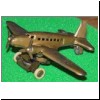 |
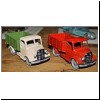 |
 |
Click
on a thumbnail to
enlarge.
Among other exhibits, Geoff Holden had several unknown record cars (pictured below). Since the clubnight, there seems to be a consensus that the wooden model is probably by Schowanek, who were making wooden toys in the German-speaking part of Czechoslovakia before the Second World War. Later, following nationalisation of the factory, they were re-established in Austria, then Bavaria. The 1:43 Jaguar shown here belongs to Ian Cook, and turns out to be made up from a Revell kit. Judging by the notes on the paper, Clive Gehle seems to have gleaned quite a few details about his selection of unknown models.
 |
 |
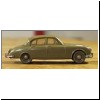 |
 |
Click
on a thumbnail to
enlarge.




